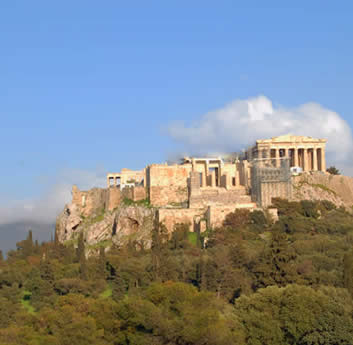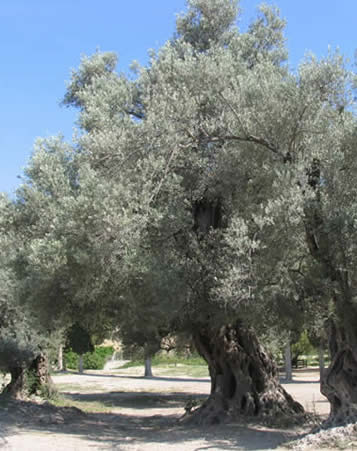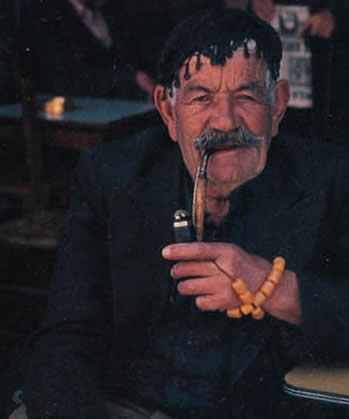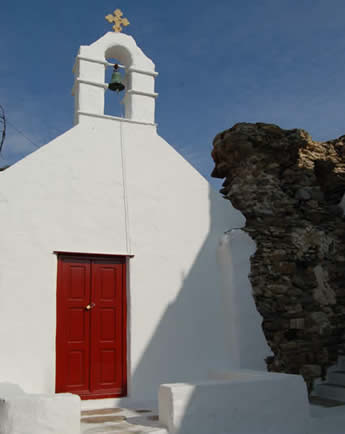South Mountain Expeditions
|
Exceptional History Tours
Home Page Our Historian 2012 Tours Past Tours Registration Form About Us Testimonials Contact Us
| 2012 Tour Schedule |
| Charleston & Savannah |
| Colorado |
| General George Washington |
FACULTY
Edwin C. Bearss is a National Treasure. One of our nation's preeminent historians, Ed's encyclopedic knowledge and unflagging energy are legendary. Ed is a decorated WWII Marine Corps veteran from the Pacific theater. He earned degrees at Indiana and Georgetown Universities before embarking on a 41-year career as an historian for the National Park Service. In 1981, he was named Chief Historian of the National Park Service, a position he held until 1994. After his retirement, he was given the title Chief Historian Emeritus, which he holds to this day. Author, lecturer and America's foremost battlefield guide, Ed brings history alive like no other. (Mr. Bearss will be our expert guide on the WWII Battle of Crete.)
Originally from Indiana, Dr. Steven Diamant has a Ph.D. from University of Pennsylvania and has lived in Greece for over thirty years. He has been a member of the College Year in Athens' faculty since 1977 where his teaching interests include a survey of all Aegean civilizations to the present, with a concentration on the earliest—Minoan, Mycenaean and Classical. He has taken part in excavations at Franchthi Cave in the Peloponnesus, Santorini, Cyprus and Turkey. He has also been the Summer School Director of the American School of Classical Studies, where he is Senior Research Associate. (Dr. Diamant will present several lectures on the history of Ancient Greece and lead us on an in-depth tour of Athens' ancient Agora).
Eleni Zachariou is a Classical historian, licensed guide and popular lecturer in her native country, Greece. She received her Master's degree in Greek history from the University of La Verne. She has been a popular study leader on scores of educational tours for clients including Smithsonian Journeys and National Geographic Expeditions. Her lecture assignments in the U.S. have included the Society of Architectural Historians at New York University and the Albany Institute of History and Art. (Eleni will be our Greek expert throughout our trip providing insight and interpretation for the ancient sites we will visit.)
Stelios Zachariou graduated from the University of New Orleans, Eisenhower Center of American Studies, with a Master’s degree in History in 1994. His focus was on Cold War Studies with an emphasis on Greek-American relations during the Eisenhower Administration. One of his principal advisers for his thesis, was Dr. Stephen Ambrose. Stelios returned to Greece and received his Ph.D. from the University of Athens were he focused on the impact of the Marshall Plan in Greece. He has worked for the Hellenic Ministry of Foreign Affairs where, among other tasks, he was the National representative to the Archives Committee for the declassification of NATO documents at NATO headquarters in Brussels. (Stelios will present one or two lectures on modern Greece since WWII.)
Classical Greece May 18-June 1, 2010 |
The mere mention of Greece evokes images of ancient temples and marble columns, white-washed villages and blue-domed churches, olive groves and the turquoise waters of the Aegean Sea. This cradle of western civilization left an indelible mark on our heritage in fields ranging from politics, philosophy, art, architecture, drama and the sciences. In May, we took an in-depth journey to this fabled country steeped in history. In addition to the major classical sites, we examined historic events and pivotal battles that had a profound impact on Western civilization. Our visits included the Persian War battlefields of Marathon, Thermopylae, and Salamis; the sacred sanctuaries of Delphi and Olympia; the Minoan palace of Knossos and the ancient citadel of Mycenae. We also spent four days under the tutelage of Ed Bearss, examining the WWII Battle of Crete, May 1941, the first airborne invasion in world history. This Was Our Itinerary Day 1, May 18, Tuesday Individual departures from the United States.
Day 2, May 19, Wednesday Individual arrivals in Athens. Join staff for a welcome reception and dinner at the hotel’s rooftop restaurant overlooking the city. Overnight at the St. George Lycabettus (R,D)
Day 3, May 20, Thursday Begin the day with two lectures by Professor Steven Diamant covering early Greek history from the Minoan and Mycenaean periods through the Persian Wars. Drive to Marathon for lunch at a taverna on the beach where the Persian fleet anchored prior to the battle. Learn about the Greeks’ stunning victory over the Persian Army at this pivotal battle and see the burial mound where the fallen Athenian warriors were laid to rest in 490 BC.
Fly to Chania on the island of Crete. Transfer to our seaside hotel where we will spend three nights. O/N Chania, Crete (B,L)
Day 4, May 21, Friday Following a lecture on the WWII Battle of Crete by Ed Bearss, we’ll drive to the site of the Maleme airfield. Walk across the historic bridge over the Tavronitis River where in the opening hours of the invasion on May 20, German gliders landed in the riverbed and quickly captured the bridge. Continue to nearby Hill 107 where the first German paratroopers landed and suffered heavy losses amongst New Zealand defenders. Today the hill is the site of the German Cemetery where over 4,000 troops are buried.
Continue to “Prison Valley” and the village of Galatas where other elements of the first wave landed in an effort to take British headquarters in Chania. Ed will describe the action as both sides fought tenaciously on the surrounding hills. We’ll stop at the WWII memorial on Cemetery Hill where a new WWII Museum is currently being constructed. O/N Chania (B,L,D)
Day 5, May 22, Saturday This morning, we’ll hear about the Battle of “42nd Street,” a final Allied assault on May 27 when Maori New Zealanders and Australians made a bayonet charge to clear a section of the Chania-Souda Road. Later that day, Command in London, having decided the cause was hopeless, ordered an immediate evacuation. Over four nights 16,000 troops were evacuated to Egypt by ship. We will follow the route the majority of these men took over the White Mountains to Sfakia on the southern coast. Following lunch at a seaside taverna, we’ll visit a private museum that displays a family's extensive collection of WWII weaponry and army memorabilia.
End the day at Souda Bay where we will pay our respects at the British Commonwealth Cemetery. O/N Chania (B,L,D)
Day 6, May 23, Sunday Stop to see Villa Bella Campania, where George II, King of Greece, stayed before narrowly escaping capture as he fled for Cairo. We’ll lunch in the old Venetian Port of Rethymnon.
The objectives of the second wave of the invasion on the afternoon of May 20, were the airfields of Rethymnon and Heraklion. Ed will discuss the action at the church of St. George and Hills A & D near the location of the Rethymnon airfield. Continue to Heraklion where we spend two nights. O/N Heraklion (B,L,D Day 7, May 24, Monday This morning, step back to 1400 BC as we follow the labyrinth of winding corridors at Knossos, fabled palace of King Minos and the Minotaur. See the outstanding collection of Minoan artifacts and frescoes at Heraklion’s Archaeological Museum.
After lunch, return to May 1941 with visits to the significant sites of the “Heraklion Sector”—the airfield (where the modern airport lies today); and the “Two Charlies” (hills overlooking the airfield.) Also tour the Historical Museum of Crete’s new WWII Exhibit. O/N Heraklion (B,L,D)
Day 8, May 25, Tuesday This morning, fly to Athens. Drive north to the site of the Battle of Thermopylae (480 BC). For seven days, Greeks led by the Spartan King Leonidas, blocked the advance of the overwhelming invading Persian army at, what was then, a narrow pass. Proceed to Delphi. En route, stop at the Gorgopotamos River where in 1942, Greek resistance fighters helped British SOE agents blow up a railroad bridge, in an attempt to break Hitler’s vital supply line to Rommel’s forces in North Africa. O/N Amalia Hotel, Delphi (B,L,D)
Day 9, May 26, Wednesday Delphi is one of the most stunning sites in all of Greece. Seat of the most famous oracle in antiquity, Delphi lies in a natural stone amphitheater clinging to the side of Mount Parnassus. Explore the remains of this sacred sanctuary dedicated to the god Apollo. Then drive to Olympia on the Peloponnesus. O/N Olympia (B,L,D)
Day 10, May 27, Thursday Today we explore Olympia, site of the first Panhellenic games in 776 BC held in honor of Zeus. Walk the length of the world’s most famous stadium and see the remains of the Temple of Zeus which housed one of the 12 Wonders of the Ancient World — a 36 ft. gold and ivory statue of Zeus.
Drive to the beautiful mountain resort of Kalavryta. According to traditional legend, the revolution for Greek independence against the Ottoman Turks was ignited here on March 25, 1821, when Bishop Germanos raised the Greek flag at a nearby monastery. March 25 is celebrated as a national holiday to this day. O/N Kalavryta (B,L)
Day 11, May 28, Friday This morning, we will visit a museum and memorial commemorating the Massacre of Kalavryta. On December 13, 1943, German troops rounded up and executed the male population of Kalavryta in retribution for the killing of 81 German soldiers by Greek resistance fighters. Drive to Epidaurus, where we will sit in the world’s best-preserved ancient Greek theater and test its perfect acoustics. O/N Amalia Hotel, Naufplion (B,L,D)
Day 12, May 29, Saturday Begin the day with a tour of Mycenae, the Bronze Age fortress of Homer’s King Agamemnon, victor of the Trojan War. See the massive stone “cyclopean” walls with the famous Lion Gate, the palace and the grave circle excavated by Heinrich Schliemann.
Continue to Corinth for lunch. En route to Athens, we’ll stop to discuss the decisive Battle of Salamis of 480 BC. The stunning Greek victory at Salamis changed the course of western history—halting the advance of the Persian Empire and setting the stage for the Golden Age of Athens. O/N Amalia Hotel, Athens (B,L)
Day 13, May 30, Sunday Join Professor Diamant for a tour of the Agora. The marketplace and civic center, it was the heart of ancient Athens and the birthplace of democracy. Visit the National Archaeological Museum which houses the country’s greatest collection of artifacts including the golden treasures of Mycenae. O/N Amalia Hotel, Athens (B,L)
Day 14, May 31, Monday Following a lecture by Professor Diamant on the Golden Age of Athens, we’ll walk to the Pnyx, the hill where the Athenian Assembly met during the 5th century BC to debate and vote on issues of the day. It was here that famous orators including Demosthenes, Themistocles and Pericles addressed the Assembly. Then take an in-depth tour of the temples atop the Acropolis, including the Parthenon, the most important surviving building of the Classical Age of Greece and one of the world’s most important cultural monuments. Toast our Greek journey at this evening’s farewell dinner. O/N Amalia Hotel, Athens. (B,L,D)
Day 15, June 1, Tuesday Depart on individual flights from Athens. (B)
GREECE PROGRAM INCLUDED: * Historian: Ed Bearss * Tour Manager: Marty Gane * Licensed Greek guide and guest lecturers * 13 nights hotel accommodations nights * 13 breakfasts, 12 lunches, 9 dinners and one wine/beer welcome reception * all taxes, baggage handling and gratuities * pre-trip notes, reading list and map book. WHAT IS NOT INCLUDED: * Airfare to Athens; passport fees; transfers to and from Athens Airport; personal items such as wine, meals not specified above; room service and laundry service; excess baggage fees; travel insurance; and other items not mentioned as included. COST: 15 DAYS/13 NIGHTS Double Occupancy: $5,195 per person Single Occupancy: $5,975 To enroll on this tour, print & complete the attached registration form and mail it with a $300 per person deposit check to: South Mountain Expeditions, P.O. Box 204, Keedysville, MD, 21756. Or call us at (301) 988-1852 or toll free at 1 (866) 914-1862. We accept VISA, Mastercard and American Express.
|





